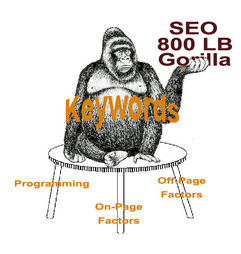Top 10 Search Engine Optimization (SEO) Mistakes in Internet Marketing
Digital Hill Multimedia, Inc.

Top Ten SEO Mistakes

Over the years I’ve been lucky enough to audit dozens of websites for SEO and search engine visibility. Some websites have been professionally developed, some built by a highschool kid and others built by the client. They all had one thing in common: The business was unsatisfied with their search engine results. Part of doing an SEO audit is to also reverse engineering the top three websites that come up for a particular search phrase the client wished to come up for. As a result, I’ve been exposed to the SEO practices of nearly 200 websites. This competitive analysis allows for the identification of SEO weaknesses and mistakes that can be exploited in the SEO process.
Below are the Top Ten Most Common SEO Mistakes in Internet Marketing
-
- Wrong keywords chosen for optimization – Do a keyword workshop before you do anything on the internet, not just SEO. It’s very important to know what people actually type into the search engines to find your products or services. This information is critical in everything you do on the internet. In my experience 90%+ of business owners are wrong when they define their primary keyword phrases without doing any research because they are industry insiders.
- Wrong keywords chosen for optimization – Do a keyword workshop before you do anything on the internet, not just SEO. It’s very important to know what people actually type into the search engines to find your products or services. This information is critical in everything you do on the internet. In my experience 90%+ of business owners are wrong when they define their primary keyword phrases without doing any research because they are industry insiders.
-
- Over saturated page titles – This is a major mistake made by even SEO professionals. The more words you put in a page title the less saturated that page title is for its primary keyword phrase. If you want your home page to come up for “Fort Wayne Plumber” because 500 people per month search that phrase, than make your page title “Fort Wayne Plumber” and not “Fort Wayne Plumber | Company Name, Commercial, Residential – Home Page.” Also, always avoid stop words like “Overview, Industry, and, the, but, etc.” in SEO.
- Over saturated page titles – This is a major mistake made by even SEO professionals. The more words you put in a page title the less saturated that page title is for its primary keyword phrase. If you want your home page to come up for “Fort Wayne Plumber” because 500 people per month search that phrase, than make your page title “Fort Wayne Plumber” and not “Fort Wayne Plumber | Company Name, Commercial, Residential – Home Page.” Also, always avoid stop words like “Overview, Industry, and, the, but, etc.” in SEO.
-
- Identical page titles & meta data – Google’s Webmaster Tools will report if your site has identical page titles or meta data on more than one page. That counts as a SEO “ding” against your site.
- Identical page titles & meta data – Google’s Webmaster Tools will report if your site has identical page titles or meta data on more than one page. That counts as a SEO “ding” against your site.
-
- No link building campaign – SEO has three main areas of consideration: Programming, on-page factors and off-page factors. Off-page factors such as incomming links from other websites are just as important to your search engine placement as the keywords in your content. Organizations seeking top SEO placement for highly competitive keyword phrases should always deploy some type of link building strategy for SEO.
- No link building campaign – SEO has three main areas of consideration: Programming, on-page factors and off-page factors. Off-page factors such as incomming links from other websites are just as important to your search engine placement as the keywords in your content. Organizations seeking top SEO placement for highly competitive keyword phrases should always deploy some type of link building strategy for SEO.
-
- No XML Sitemap – An XML Sitemap is a file that can be submitted to all of the major search engines telling them what pages they need to spider on your site. Idealy, you want to have a dynamic sitemap instead of a static one. That way, if you add pages of content in the future the sitemap will automatically update itself to reflect those changes.
- No XML Sitemap – An XML Sitemap is a file that can be submitted to all of the major search engines telling them what pages they need to spider on your site. Idealy, you want to have a dynamic sitemap instead of a static one. That way, if you add pages of content in the future the sitemap will automatically update itself to reflect those changes.
-
- Forgeting about alt tags & link text – Don’t forget to add content for handicapped website visitors. The blind use text reading tools to navigate the web and alt tags tell the text readers what images and graphics are. Link text explains to the person where a link goes to. Google also reads this content and it can be used for SEO.
- Forgeting about alt tags & link text – Don’t forget to add content for handicapped website visitors. The blind use text reading tools to navigate the web and alt tags tell the text readers what images and graphics are. Link text explains to the person where a link goes to. Google also reads this content and it can be used for SEO.
-
- No H1’s or H1’s with no keywords – This is the most prevalent SEO mistake seen on most websites. Based on my experience, a header 1 tag on a page is the second most important on-page factor for SEO. Just like page titles you need to make sure it contains your primary keyword phrase, it’s not over saturated with meaningless words and always avoid stop words.
- No H1’s or H1’s with no keywords – This is the most prevalent SEO mistake seen on most websites. Based on my experience, a header 1 tag on a page is the second most important on-page factor for SEO. Just like page titles you need to make sure it contains your primary keyword phrase, it’s not over saturated with meaningless words and always avoid stop words.
-
- Less than 250 words on a page – Every page should have over 250 words and less than 1000 words. If you find that you need more than 1000 words for a page then consider creating subpages to break up the content. Any words over 1000 Google does not index, but ignores.
- Less than 250 words on a page – Every page should have over 250 words and less than 1000 words. If you find that you need more than 1000 words for a page then consider creating subpages to break up the content. Any words over 1000 Google does not index, but ignores.
-
- Stale content – Google has a vested interest in showing the most relevant and fresh content the web has to offer. If you never update your content it will become stale and Google will find it less relevant for its SERPs.
- Stale content – Google has a vested interest in showing the most relevant and fresh content the web has to offer. If you never update your content it will become stale and Google will find it less relevant for its SERPs.
-
- Under saturated content – Each search engine has their own keyword saturation recommendations for SEO. As a rule of thumb I’m shooting for between 3% and 7% saturation. In addition, you want to make sure you have keyword phrases in the first paragraph, middle of page and last paragraph of your content. Below is the formula for determining keyword ratios:
*As seen in Writing for the Web: SEO Guidelines for Copywriters
Example: keyword phrase = Ford Mustang Tires
# of total words on page = 600
# of words in keyword phrase = 3
600 ÷ 3 = 200
# of times key word phrase is in content = 10
10 ÷ 200 = 5%
